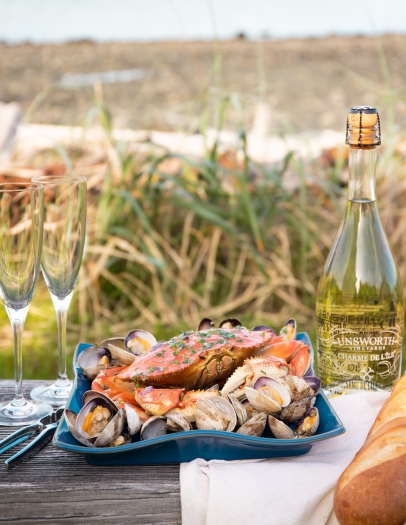Corks & Bait
Living by the ocean definitely has its perks, especially if you’re a hobby fisher (or friends with one, for that matter). Fresh crab on the porch after a day in the sun is a combo that can’t be topped—except for maybe with the addition of a glass of wine. The perfect end to the perfect day on the water includes a stop at your local winery to grab a bottle of vino. But what kind of wine would be best for today’s catch?
Let's start with the basics of pairing. There are a few simple rules you can follow when pairing wine with food:
1. The wine should be more acidic than the food. The easiest way to measure the acidity of a wine is by evaluating how much it makes your mouth water. The more your mouth waters, the more acidic the wine.
2. The wine should be sweeter than the food to avoid a bitter after taste.
3. The wine intensity should match the flavour intensity of the food.
Now let’s dive a bit deeper into seafood pairings.
Mollusks, such as oysters, clams, scallops or mussels, pair best with a sparkling white like Champagne or Prosecco. If you’re out of bubbles, other dry white wines are an average pairing, but stay away from the reds.
Fish like halibut, lingcod, salmon, trout, etc., pair best with a light-bodied white wine such Pinot Grigio/Pinot Gris, unoaked Chardonnay and Chenin Blanc. Medium-bodied whites and sparkling whites will also do in a pinch, but in most cases red wines should be avoided.
Crustaceans, such as shrimp, prawns and crab, are the most versatile seafood to pair with wines. Most crustaceans will be a perfect match with any sparkling, light-bodied white, full-bodied white or aromatic white wine, so get creative with your choices! Rosés and light-bodied reds are also an average pairing, but still stay away from the medium and full bodied reds.
By now, you may have noticed a pattern with white wine and seafood. White wine pairs best with light intensity meats such as seafood and chicken. Generally, stay away from pairing red wines with seafood due to the higher levels of tannins. Tannins are naturally occurring polyphenols found in grape skins, seeds and stems. They give wines texture and complexity, and can be described as astringent or bitter tasting, leaving a dry or “grippy” feel in your mouth. During wine production, red grapes are typically fermented with their skins, stems and seeds, leaving the wine with more tannin. Unfortunately, tannins and fish oils can react together creating a bitter, metallic taste in your mouth. White grapes, however, are juiced and separated from their skins for the juice to be fermented on its own. This creates wine that is much less tannic, leaving us with the perfect beverage for seafood.
Vancouver Island has many well-established vineyards positioned throughout the various microclimates up and down the Island—there is certainly no shortage of quality wine. If you’re looking for local wines to pair with some local grub, try some of these combinations:
Pair your freshly caught crab or prawns with Quill Pinot Gris by Blue Grouse Estate Winery. This medium-bodied white boasts notes of ripe pear, Granny Smith apple, orange and fresh herbs.
For fish and chips takeout night, try pairing your two-piece battered halibut with the Sauvignon Blanc by Alderlea Vineyards in the Cowichan Valley. Alderlea is one of the few vineyards on Vancouver Island to grow Sauvignon Blanc grapes. This wine boasts flavours of green apple, nectarine and freshly cut grass with a balanced acidity and clean finish. If you opted for the two-piece cod, try the Uncloaked Chardonnay by 40 Knots Winery. This is a crisp and fresh unoaked Chardonnay that has been aged eight months in stainless steel.
Try pairing oysters with Charme de l'ile, an aromatic prosecco-style bubbly (aged in large steel tanks), by Unsworth Vineyards in the Cowichan Valley. The addition of bubbles against the silky mouthfeel of oysters provides an appealing textural contrast alongside the umami flavour of the oysters.
Finally, Damasco, a blend of Vancouver Island Bacchus, Ortega, Auxerrois and Madeleine Sylvaner grapes by Zanatta Winery, is the perfect pair with your choice of fin fish or even a seafood linguine. This fruity, off-dry and slightly effervescent wine has medium acidity and a clean finish, making it ideal for a slightly meatier fish like tuna or salmon.
The final—and arguably most important—tip to remember is that wine pairing is about exploration and is unique to each individual. At the end of the day, the owner of the taste buds is the final judge of what goes well together and what doesn’t, so don't be afraid to experiment for yourself to find your own preferred pairings.





